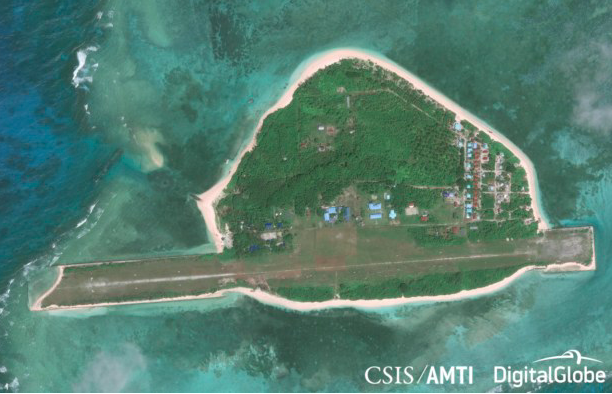
The Philippines has started to counter Beijing’s militarisation of the South China Sea by updating its own facilities in the disputed waters.
The Asia Maritime Transparency Initiative (AMTI, a US think tank) has released satellite images showing that the Philippines has begun long-delayed repairs to its crumbling runway at Thitu (Pag-asa) Island.
The runway’s poor condition and a collapse of its western end had made landings and takeoffs dangerous, particularly in the rainy season.
Thitu is the largest of Manila’s nine outposts in the disputed Spratly island chain. It is also home to at least 100 civilians and a small military contingent.
According AMTI, a comparison of recent imagery show that as well as airstrip repairs, minor upgrades were made to other facilities on Thitu, and at least seven new buildings have been constructed.
Minor improvements have also been spotted at Commodore Reef (Rizal) and Loaita Cay (Panata Island) and a helipad has been constructed on Nanshan Island (Lawak).
“Philippine defence officials in April 2017 announced that they would be upgrading facilities at the country’s occupied islands and reefs, but little work was apparent until now,” said AMTI.
The Philippines claims parts of the South China Sea within its exclusive economic zone, which it officially calls the West Philippine Sea.
Ties between China and the Philippines soured after the Aquino administration filed a case in 2013 with a UN-backed tribunal. The ruling, which favoured Manila, was handed down shortly after President Duterte took office.
However, China refused to acknowledge the decision. Meanwhile, President Duterte also downplayed the result in exchange for warmer ties and Chinese funding for his ambitious infrastructure programme.
Militarisation continues
AMTI’s latest report comes after China announced it had landed strategic bombers, including the nuclear-capable H-6K, on an outpost in the South China Sea.
Nearly all of the Philippines falls within the radius of the strike aircraft, the AMTI said.
Beijing had also reportedly installed anti-ship cruise missiles and surface-to-air missile systems on three Manila-claimed reefs in the sea.
However, President Duterte said it’s pointless to resist Beijing’s deployment of its air assets to the contested waters and dared his critics to “go to war with China”.
Chinese foreign ministry spokeswoman Hua Chunying earlier said China has been involved in peaceful construction in the islands, which includes “the deployment of necessary national defence facilities”.
In response, the White House warned China of “near-term and long-term consequences” over its militarisation in the South China Sea. The US did not clarify what these consequences could be.

Comments are closed.